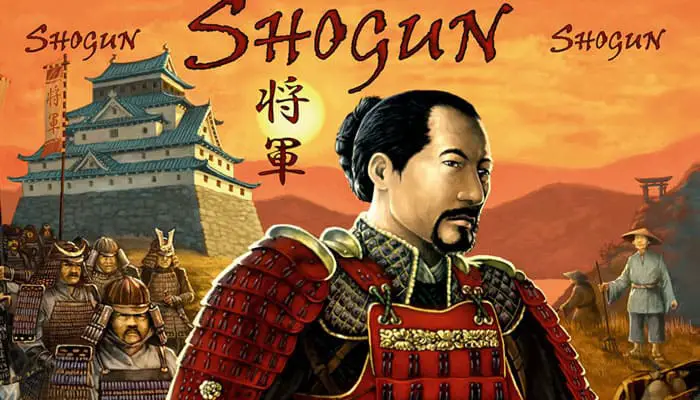
Game Components

- The Game Board with 2 sides (1 with a sun and 1 with a moon).
- 53 Province Cards
- 25 War Chest Cards
- 5 Special Cards
- 10 Action Cards
- 12 Event Cards
- 5 Daimyo Cards
- 5 Individual Boards
- 310 Colored Cubes representing player armies, with 62 in each player color
- 20 Green Cubes - representing neutral farmer armies
- 55 War Chests
- 5 Victory Point Markers
- 5 Rice Markers
- 80 Building Tiles - 28 castles, 26 temples, and 26 Nô theaters.
- 42 Revolt Markers
- 1 3-Part Battle Tower
- 1 Storage Tray
- 1 Supplement
- 1 Set of Game Rules
Object of the game
As warlords in 16th-century Japan, the players attempt to secure a position of dominance for their respective clans. The most successful Daimyo at the end of the game will become SHOGUN.
To succeed, a player will need not only to control as many provinces as possible, but also to develop his realm by building castles, temples, and theaters.
The player who manages to build the most buildings in each of the 5 regions will be rewarded with valuable bonus points.
Setup
Provinces in the Game
Players choose whether to play on the sun or moon side of the game board and then lay out the board accordingly. Un-needed province cards are set aside (players should keep only those with symbols matching the chosen side of the board).
With only 3 players, 8 province cards will not be needed and are returned to the box. These 8 provinces are marked on the board with a special symbol and a light border.
During the game, no armies may be moved into these unused provinces.
Player Materials

Each player chooses a color and takes the matching pieces: an individual board along with 62 armies (i.e., 62 cubes in the player's color), a Daimyo card, a set of chest cards (0 to 4 chests), and starting capital as follows:
- with 3 players, each takes ... 18 Chests,
- with 4 players, each takes ... 15 Chests,
- with 5 players, each takes ... 12 Chests.
Each player's armies and chests must remain visible to the other players during the game. When playing with fewer than 5, all unnecessary components are returned to the box.
Claiming Starting Provinces
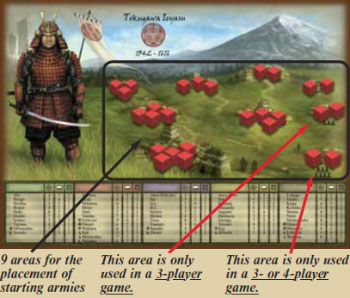
The province cards are shuffled and placed in a face down stack near the board. Then the top 2 cards are turned face up.
The front side of the individual boards shows 9 countryside areas next to the Daimyo, each marked with a number.
Each player places the displayed number of armies on each area of his individual board (7 to 9 areas are used, depending on the number of players). The armies in each area form a group.
Players deploy these army groups to their respective starting provinces as follows: beginning with the oldest player and then in turn, each chooses 1 of the 2 face up province cards or draws the top card from the face down draw pile and then transfers an army group of his choosing from his individual board to the matching province on the game board.
The player then takes the chosen province card into his hand.
If a face up card was taken, it is replaced with another from the draw pile.
This process continues until each player has transferred all of his army groups onto the game board.
The remaining province cards (which do not belong to any player) are placed within reach near the game board.
These provinces may be conquered during the game. After claiming starting provinces, each player turns over his individual board so that the side showing the action spaces is face up.
The player's remaining armies form his individual supply.
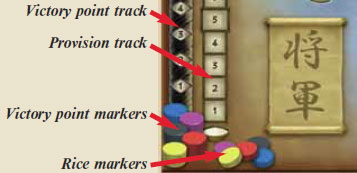
Victory Point Markers and Rice Markers
All players set their victory point markers on the "0" space of the scoring track, and their rice markers next to the bottom of the provision track.
The Battle Tower
Now, the tower must be loaded with an initial set of armies.
Seven armies from each player and a total of 10 farmer armies are dropped together into the tower.
Armies that fall back out into the tower tray are returned to their respective supplies.
Remaining farmer armies form a general supply.
War Chests
Chests are used to pay for the various actions. After each player takes his starting chests, the remaining chests form a general supply.
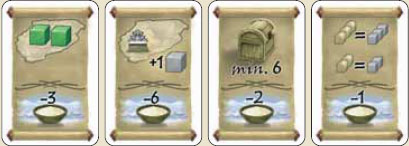
Event Cards
Event cards are shuffled and placed in a face down draw pile.
The top 4 event cards are then turned face up next to the game board.
During each of the next 3 rounds, 1 of these events takes effect for all players.
In the fourth round (winter), the remaining event card shows how much rice each player loses over the winter.
The action cards and special cards should be placed within easy reach.
Tutorial Video
Game play
The game transpires over 2 years, which are divided into a total of 8 rounds: after 3 rounds representing spring, summer, and fall, a fourth scoring round (winter) takes place.
This sequence of 4 rounds is then repeated.
Spring, Summer, and Fall
Each of these 3 rounds occurs in the following steps:
- Lay Out Action Cards
- Lay Out Special Cards
- Plan Individual Actions and Bid for Turn Order
- Determine Events
- Determine Turn Order
- Carry Out Actions
Lay Out Action Cards
Actions are the core of the game. All 10 actions are shown on the individual boards. Each player may carry out each action in his realm once per round.
The order in which these actions are taken is determined anew each round. To do so, the 10 action cards are shuffled and placed in face down pile. Then the top 5 are revealed 1 at a time and laid out in order beneath fields 1 through 5 at the bottom of the game board. Next to these, the remaining 5 cards are laid out face down beneath fields 6 through 10.
Lay Out Special Cards
The special cards are shuffled and then placed face up in the order in which they are drawn on the 5 spaces marked for them on the game board. Later in the game, these cards will be auctioned to the players. Each special card has 2 functions: first, its position in the row on the board determines the turn order of the player who takes the card, and second, the card shows a privilege granted to its owner for the current round.

+1 War Chest - When taking the action "Collect Taxes", the player receives 1 extra chest.
+1 Rice - When taking the action "Confiscate Rice", the player receives 1 extra unit of rice.
6 Armies - When taking the action "Deploy 5 Armies", the player may deploy 6 armies instead.
+1 Army with Attack - An attacking player who takes the action "Battle / Move A and B" may place 1 extra army in the battle tower.
+1 Army with Defense - A defending player may place 1 extra army in the battle tower when one of his provinces gets attacked by another player taking the action "Battle/Move A and B".
Plan Individual Actions and Bid for Turn Order
Simultaneously, each player secretly decides how to distribute his 10 actions among his provinces.
Each player selects 1 of his province cards and places it face down on the chosen action space on his individual board.
The actions are as follows:
Build a Castle - The player pays 3 chests to the general supply and places a castle in the chosen province.
Build a Temple - The player pays 2 chests and places 1 temple.
Build a Nô Theater - The player pays 1 chest and places 1 Nô theater.
Note that a building-whether a castle, temple, or theater -may only be placed on an unoccupied building space. Each province contains from 1 to 3 such building spaces. No province may contain more than one of the same building type.
Confiscate Rice - A player is credited the number of rice units shown on the chosen province card. To indicate this gain, the player's rice marker is moved up on the provision track accordingly.

Collect Taxes - The player takes from the general supply the number of war chests shown on the province card.
When a player collects taxes or rice from a province, it is possible that a revolt will occur.
If no revolt occurs, or if a revolt is successfully put down, 1 revolt marker is placed in the province.
Deploy 5 Armies - The player pays 3 chests and deploys 5 armies from his individual supply to the chosen province.
Deploy 3 Armies - The player pays 2 chests and deploys 3 armies to the chosen province.
Deploy / Move 1 Army - The player pays 1 chest and deploys 1 army to the chosen province.
Additionally, the player may move armies from this province into 1 of his own adjacent provinces. (No battling is permitted!)
In general, the following applies to army movement: Any number of armies may be moved to an adjacent province except that at least 1 army must remain behind.
There is no limit to the number of armies that may occupy a given province. Provinces joined together by a sea route (dashed lines) are considered to be adjacent.
Battle / Move -A- - Armies are moved from the selected province into an adjacent one. If the adjacent province does not belong to the moving player (i.e., the adjacent province is neutral or owned by another player), a battle ensues.
The rule requiring that at least 1 army remain behind in the originating province still applies.
Battle / Move -B- - The same rules apply as for -A-.
If a player does not want to take a particular action in his realm, he places 1 of his war chest cards on the undesired action space. In this case, any chests on the card are ignored.
Bid for Turn Order
Additionally, each player must secretly bid for turn order and the accompanying special privilege. To bid, the player lays 1 of his unused chest cards or province cards face down onto the auction space on his individual board.
To the extent possible, 1 card must be placed face down on each of the 11 spaces on a player's individual board. No space may contain more than 1 card.
Determine Events

The face up event cards are shuffled (there will be 2, 3, or 4, depending on which round is in progress).
One is then drawn and placed face up on the event space on the game board. The card depicts the event that applies in this round to alter certain actions for all players.
The remaining event cards are laid out face up next to the game board.
Determine Turn Order
The players reveal their bids (the cards on their auction spaces) and pay the amounts shown to the bank. If a player bids with a province card, he pays nothing.
In order of their respective bids (with the high bidder going first), each player establishes his position in the turn order by taking 1 of the special cards and replacing it with his own Daimyo card. When all have finished, any remaining special cards are set aside for this round.
Players who bid a province card choose before those who played chest cards with 0 chests.
Only then do players who did not bid a card make their selections. (This can only occur when a player does not have enough province cards).
If more than 1 player makes the same bid, the tied players shuffle their Daimyo cards and turn them up 1 at a time, thereby establishing the order in which they make their selections.
The positions of the Daimyo cards on the game board indicate player turn order. (In games with 3 or 4 players, empty spaces are ignored).
Carry Out Actions
Actions are executed in the order in which the action cards are lined up below the game board.
Each action is executed by all players in turn order before the next action is carried out.
All players who can carry out an action must do so. If a player ends up being unable to take a particular action or is only able to take part of the action, then he skips the action entirely in this round.
When all players have taken an action, the next face down action card is revealed.
The round ends when all 10 actions have been taken. Each player takes back his Daimyo card and turns in his special card. The event card from this round is now removed from play.
The action cards are reshuffled, and the next round begins.
If, however, the round that was just completed was the fall round, then the winter round takes place.
Winter Round
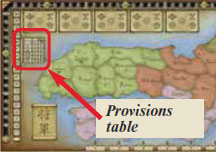
In this round, players must supply their provinces with rice or face the threat of revolt. Additionally, scoring occurs.
Supplying Provinces with Rice
Now, each player's stores of rice sustain losses. The remaining fourth event card shows how many units of rice each player must give up. Player rice markers are moved down accordingly on the provision track.
Now, each player must possess 1 unit of rice for each of his provinces. If a player does not have provisions for each of his provinces, then 1 or more revolts takes place in his realm.
Revolts
The provisions table on the game board determines the number of provinces experiencing revolts, as well as the strength of the revolts.
The besieged player's left neighbor draws randomly from that player's hand a number of province cards (not chest cards!) equal to the number of provinces experiencing revolts.
These are the provinces in which revolts now occur. If a player faces more than 1 revolt, he chooses the order in which they occur.
Scoring
The players now earn victory points for their provinces and buildings as well as for having the majority of a building type in a region:
For each of a player's provinces-1 victory point (VP).
For each building 1 VP.
For most castles in a region* 3 VP.
For most temples in a region* 2 VP.
For most Nô theaters in a region* 1 VP.
* If 2 or more players tie, each of the tied players receives the full number of victory points minus 1.
Players move their victory point markers forward a space on the victory point track for each victory point they earn.
After the first 4 rounds, 4 new event cards are revealed, all rice markers are reset to 0, and all revolt markers are removed from the provinces.
Four more rounds follow (spring, summer, fall, and winter), ending again in winter with the second and final scoring round.
Resolving Battles
General Rules for the Battle Tower
All battles are fought with the aid of the battle tower. A player takes all participating armies (colored cubes of the attacker and defender) and throws them into the tower together with all cubes lying in the tower tray at the start of the battle. In the process, some of these cubes will remain in the tower, and some that were already inside the tower will fall out into the tray, thus producing a chance result.
The tower must never be intentionally emptied (only at the end of the game!). Any cubes that fall out accidentally during the game should be left lying in the tower tray. These cubes should be thrown back into the tower at the time of the next battle.
>When Do Battles Take Place?
Battles take place in the following situations:
- Player versus Player - A player moves his armies into another player's province (i.e., a province already containing another player's armies).
- Player versus Neutral Province - A player moves his armies into a province that does not contain any armies (such a province belongs to no one and is considered neutral).
- Farmers Rise Up Against a Player (Revolt) - A revolt in a player's province can result from either of 2 occurrences:
- Rice / Tax Collection - A player collects rice or taxes from a province already containing at least 1 revolt marker;
- Winter Shortages - A player is unable to supply rice to all of his provinces in winter.
Participants in Battle
Player versus Player or Neutral Province
The attacker always battles with all of the armies that he moved into the province.
The defender adds to this all of his armies from the contested province.
If the province is neutral, then 1 farmer army from the general supply is thrown into the tower instead.
Moreover, as in other battles, all armies in the tower tray are also thrown into the tower.
Farmers Rise Up Against a Player (Revolt)
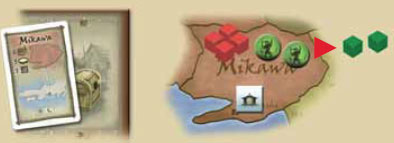
The player is considered the defender and fights with all of his armies from the embattled province.
Moreover, for each revolt marker in the province at the time of the uprising, 1 more farmer army from the general supply joins the battle.
Revolt in Winter
If the revolt occurs during a winter round, additional farmer armies, as determined by the provisions table on the game board, also join the battle.
Again, as in other battles, all armies from the tower tray are thrown into the tower.
Battle Results and Consequences
To determine the outcome of the battle, players count up the number of attacking and defending armies that come out into the tower tray. The side with the most armies in the tray wins.
Armies not participating in the battle are disregarded and remain lying in the tray.
Player versus Player or Neutral Province
If there are no revolt markers in the defender's province, all farmer armies in the tower tray count for the defender. (After a battle that includes farmers, all green cubes in the tray are returned to the farmer supply. If farmers are not involved in the battle, the green cubes remain in the tray).
The side with fewer total armies in the tray is defeated, and all armies that fought on that side are removed from the tray and returned to their respective supplies. The victor, despite the win, also loses as many armies as the defeated side and returns them to their supply as well. The remaining victorious armies are placed in the contested province.
The province card is taken or kept by the victor (as the case may be). If a battle remains undecided, then all armies from both participants are removed from the tower tray and returned to their supplies. All buildings, armies, and revolt markers are removed from the contested province. The province card is returned to the supply.
Farmers Rise Up Against a Player (Revolt)
If the farmers win or the battle is undecided, all participating armies are removed from the tray and returned to their respective supplies. All buildings and revolt markers are removed from the province. The province card is returned to the supply. If the player wins, he removes from the tray a number of his own armies equal to the number of defeated farmer armies, returning them to his individual supply. He then transfers his remaining armies from the tray into his province and returns the defeated farmer armies to their general supply.

End of the Game
The game ends after the second winter round with the final scoring. The player with the most victory points wins.
In case of a tie, the player with the greatest number of war chests wins.
Continue Reading

